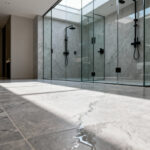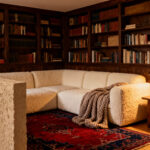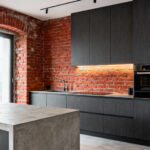Picture this: You’re standing in your living room, and it feels… tight. You know it has potential, but every piece of furniture feels like it’s in a standoff with the others. The natural impulse is to shove everything against the walls and hope for the best, creating a weird, empty dance floor in the middle of the room. It’s the number one mistake I see, and it drives me nuts because it makes a small space feel even smaller and less inviting.
Everyone says, “Just buy smaller furniture!” but that’s lazy advice. It’s not about shrinking your life to fit your apartment; it’s about making your space work smarter for you. A living room isn’t just a container for your stuff. It’s the backdrop to your life, and it needs a system. I used to think beautiful design was about having expensive things. Then I spent years designing custom cabinetry for tiny, awkward city spaces, and I learned the hard way that the most beautiful design is the one that solves a problem elegantly. It’s about function, flow, and making every single inch count. So, let’s talk about how to get it right.
Laying the Groundwork: Vision & Practicality (Part 1)
Before you buy a single pillow or paint a single wall, you have to do the prep work. This is the part everyone wants to skip, and it’s precisely why most decorating projects end in frustration and a pile of return receipts. Think of this as creating the blueprint. Without a blueprint, you’re just guessing, and guessing is expensive.
1. Define Your Personal Style to Create a Harmonious Apartment Aesthetic
Most people start their decorating process by scrolling, seeing a cool green velvet sofa, and buying it on impulse. Then they get it home and realize it looks like a confused alien in their otherwise beige room. Defining your style isn’t about being trendy; it’s about creating a visual filter for every decision you make. It’s your no-BS guardrail that keeps you from wasting money on things that don’t belong in your story.
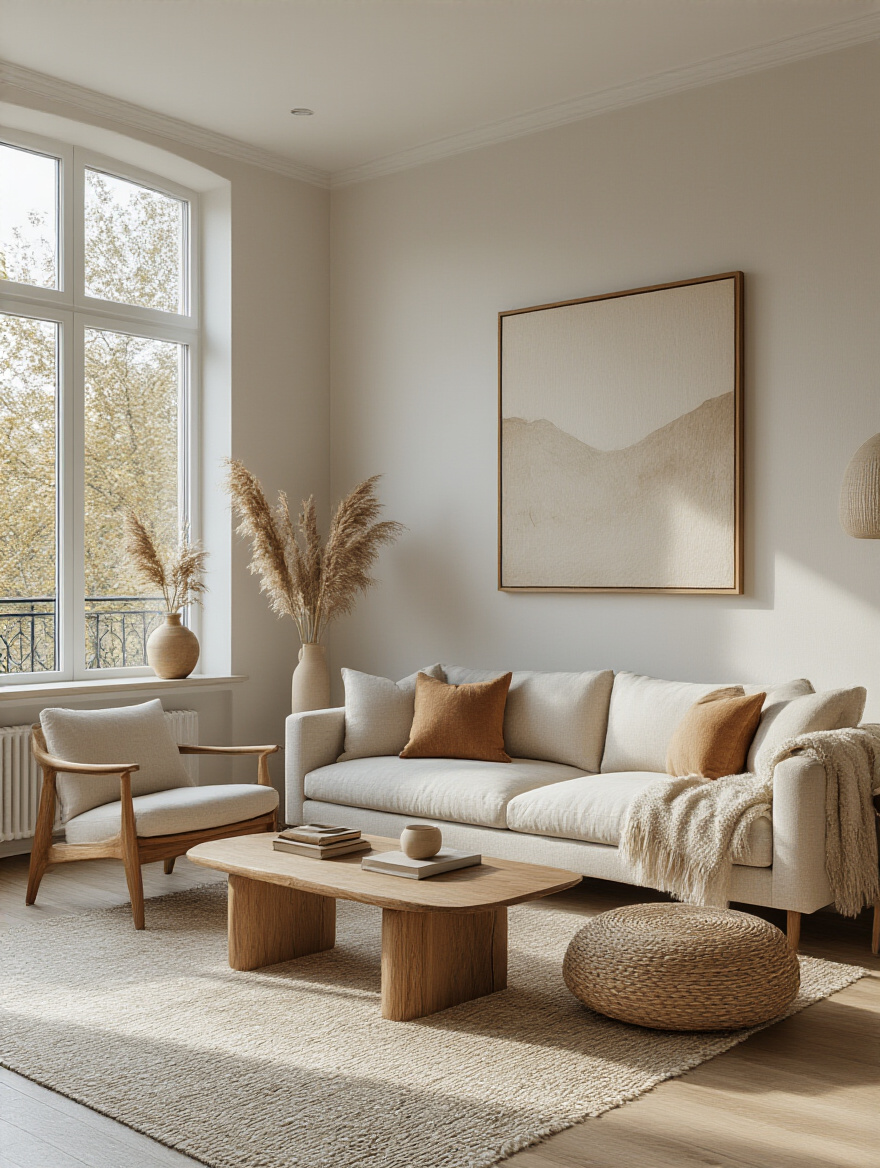
To figure it out, forget interior design for a second and look in your closet. What colors, textures, and patterns do you buy over and over? Are you all about clean lines and neutrals, or are you drawn to worn-in leather and cozy knits? That’s your style. Create a Pinterest board and be ruthless. Don’t just pin anything pretty; pin rooms that feel like you. After a week, look for the patterns. Those 3-5 words you’d use to describe that board? That’s your style guide.
Now that you have your core style, every other decision becomes simpler. You can focus on finding the right pieces instead of getting distracted by every shiny object on the internet.
2. Sketch a Scaled Floor Plan to Maximize Functional Space Efficiently
I know, this sounds like homework. But I can’t tell you how many clients I’ve watched waste hundreds, even thousands, of dollars because they “eyeballed it.” A floor plan is the single most powerful tool for maximizing a small space. It turns a vague idea into a concrete plan and prevents the soul-crushing moment of realizing your dream sofa physically blocks the only pathway to your balcony.
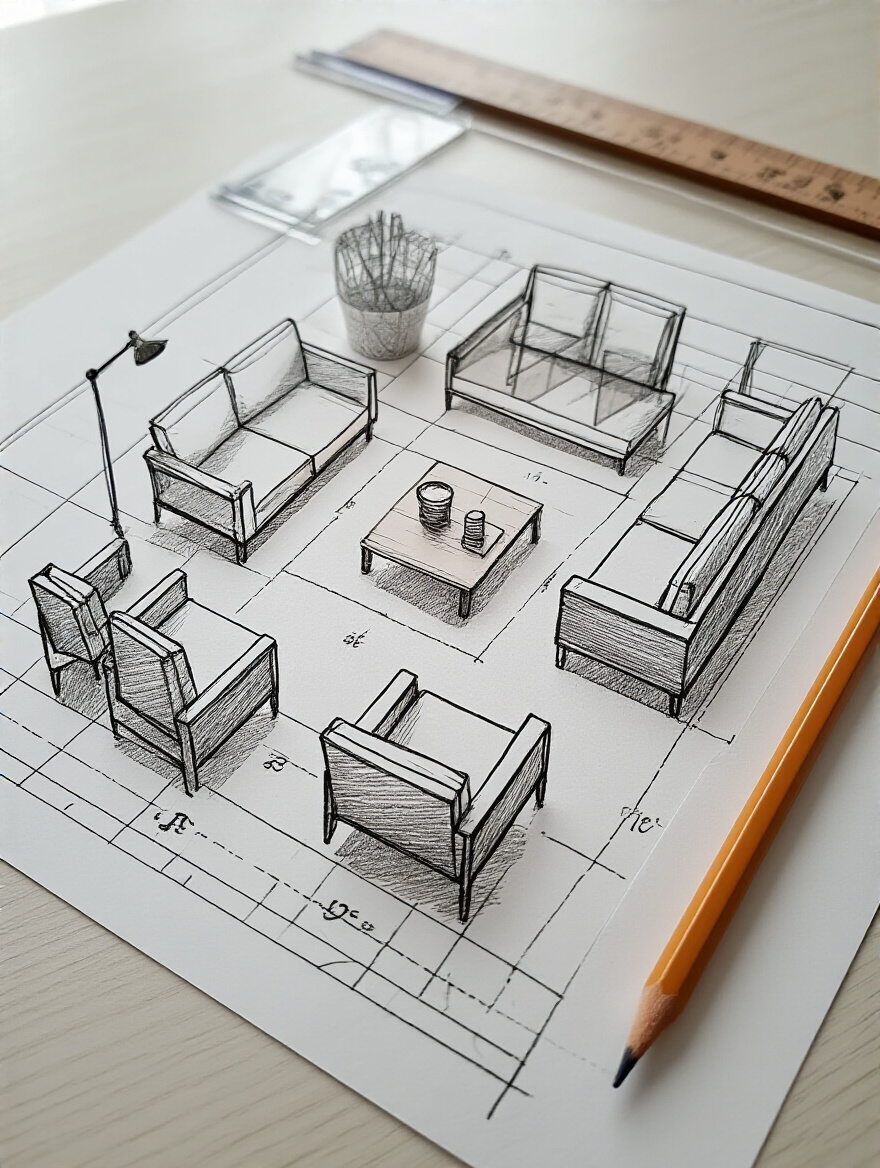
Grab a tape measure, graph paper (or a free app like RoomSketcher), and get your room’s dimensions. Then, measure the furniture you own or plan to buy. Cut out little paper versions of each piece to scale and slide them around on your paper floor plan. Can you walk around the coffee table? Is there at least 30-36 inches for a major walkway? Does the layout feel balanced? Answering these questions now will save you a world of hurt later. A shortcut I love is to use painter’s tape to outline potential furniture right on your floor. It gives you a real-world feel for the scale before you commit.
This single step will give you more clarity than hours of shopping, ensuring every piece you choose will fit and function perfectly from the start.
3. Identify Key Living Zones to Optimize Room Flow and Activity
Your apartment living room isn’t just one room; it’s probably three or four rooms in disguise. It’s your home office, your movie theater, your dining room, and your lounge. Without defining zones for these activities, everything blends into a chaotic mess. Strategic zoning creates invisible walls, making the room feel more organized and far more functional. It’s about giving every part of your room a clear job.
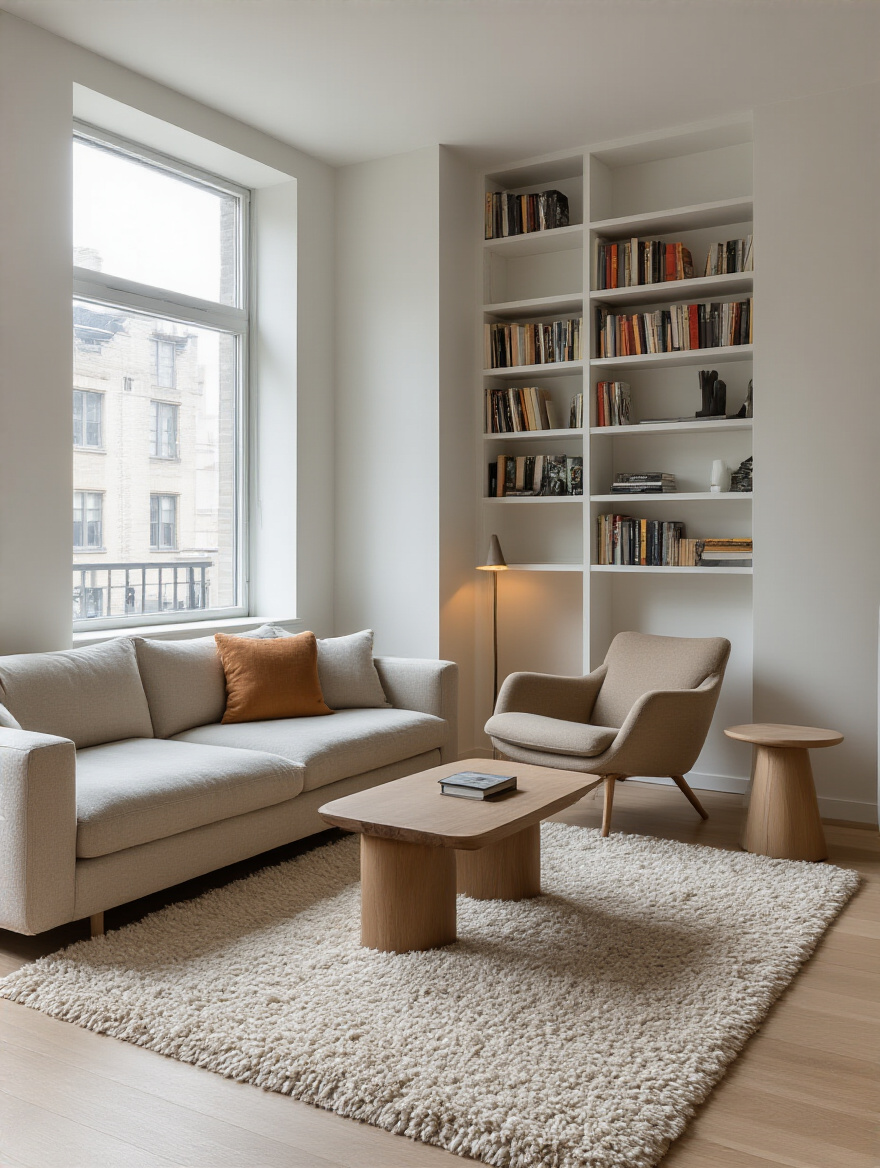
The easiest way to do this is with an area rug. A rug under your sofa and coffee table instantly says, “This is the relaxing zone.” A console table pushed against the back of the sofa can create a subtle divider and a designated “work zone” with a slim desk chair. The goal is to group furniture by function. Your seating should be close enough for conversation, your reading chair should have its own lamp, and your dining spot should be distinct from where you watch TV.
A client of mine had a long, narrow living room that felt like a bowling alley. We used a large rug to anchor the seating area at one end and a slim bookcase to create a visual break for a small dining nook at the other. The room instantly felt more purposeful and balanced.
4. Select a Cohesive Color Palette that Enhances Mood and Expands Perception
Color isn’t just decoration; it’s a space manipulator. The right palette can make a cramped room feel airy and open, while the wrong one can make it feel like the walls are closing in. Most people just pick a shade of white they think is “safe” and call it a day, but they often ignore the undertones, which is why their “safe” white room ends up looking sterile or dingy.
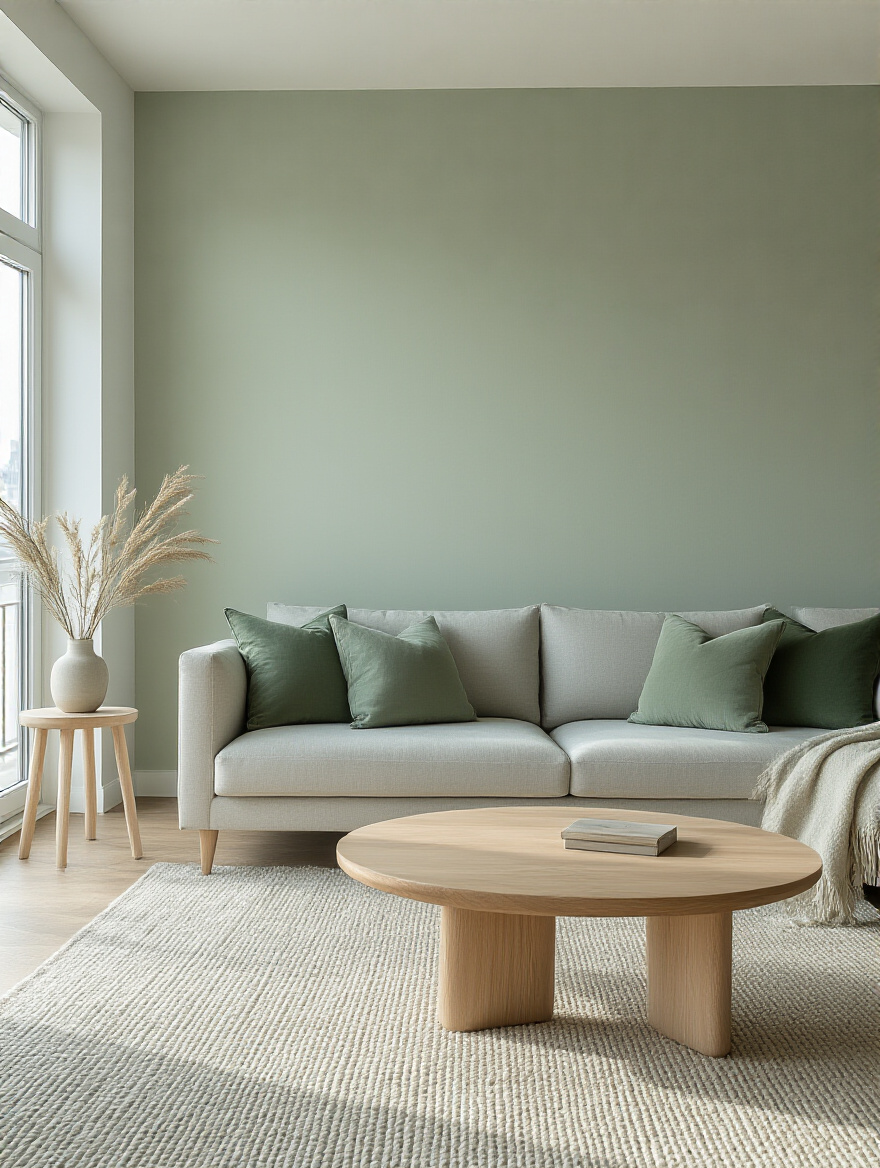
A great shortcut is the 60-30-10 rule. 60% of your room should be your dominant color (usually your walls), 30% a secondary color (furniture, curtains), and 10% an accent color (pillows, art). For small spaces, stick to light, cool-toned colors like soft blues, greens, and grays for your 60%, as they visually recede and make walls feel farther away. Most importantly, always test paint swatches on your actual walls. The light in your apartment is unique and will completely change how a color looks.
A cohesive palette ties everything together, creating a seamless flow that tricks the eye into seeing one large, unified space instead of a collection of disconnected objects.
Laying the Groundwork: Vision & Practicality (Part 2)
Once your foundational blueprint is in place, it’s time to consider the one element that can make or break any room, especially a small one: light. This isn’t just about flipping a switch; it’s about strategically sculpting the atmosphere of your room.
5. Assess Natural Light and Plan Supplemental Lighting Needs Strategically
I’ve seen gorgeous furniture and perfect color palettes fall completely flat in a room with bad lighting. People often rely on a single, harsh overhead light—what designers call “the interrogation lamp”—which casts unflattering shadows and makes a space feel flat and unwelcoming. The secret to great lighting is layering it, just like you layer clothes or textures.
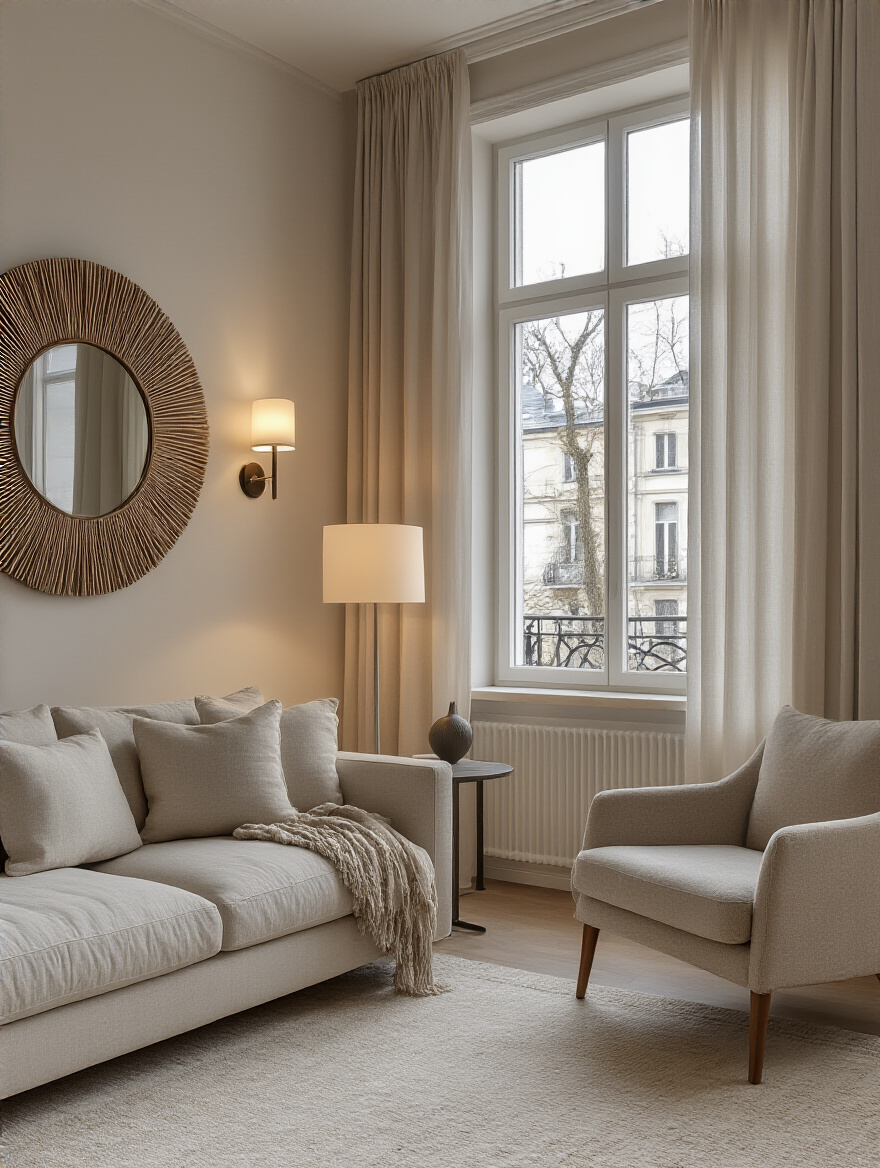
Think of your lighting in three layers. First, Ambient light is your general, overall illumination, like that ceiling fixture (put it on a dimmer!). Second, Task light is focused light for specific activities, like a reading lamp by a chair or under-cabinet lighting. Finally, Accent light is for creating mood and highlighting features you love, like a picture light over a piece of art or an uplight behind a plant. A room with all three layers feels balanced, functional, and about a thousand times more expensive than it is. Pay attention to your natural light, too—if you have a dark corner, that’s the perfect place for a stylish floor lamp to bring it to life.
By thinking of light as a crucial design tool instead of an afterthought, you can craft a space that feels bright and airy during the day and warm and intimate at night.
Furnishing Essentials: Core Layout & Key Pieces (Part 1)
Now for the fun part: the furniture. But this isn’t about just picking things you like. In an apartment, every single piece needs to earn its spot. Your furniture should be like a team of hard-working employees, each with multiple skills.
6. Choose Multifunctional Furniture to Boost Utility in Compact Areas
If you live in a small space, single-purpose furniture is a luxury you can’t afford. Why have a coffee table when you can have a coffee table that lifts to become a desk and has hidden storage inside? Why have an ottoman when you can have a storage ottoman that moonlights as extra seating for guests? This is the core principle of small-space living: make every piece pull double or even triple duty.
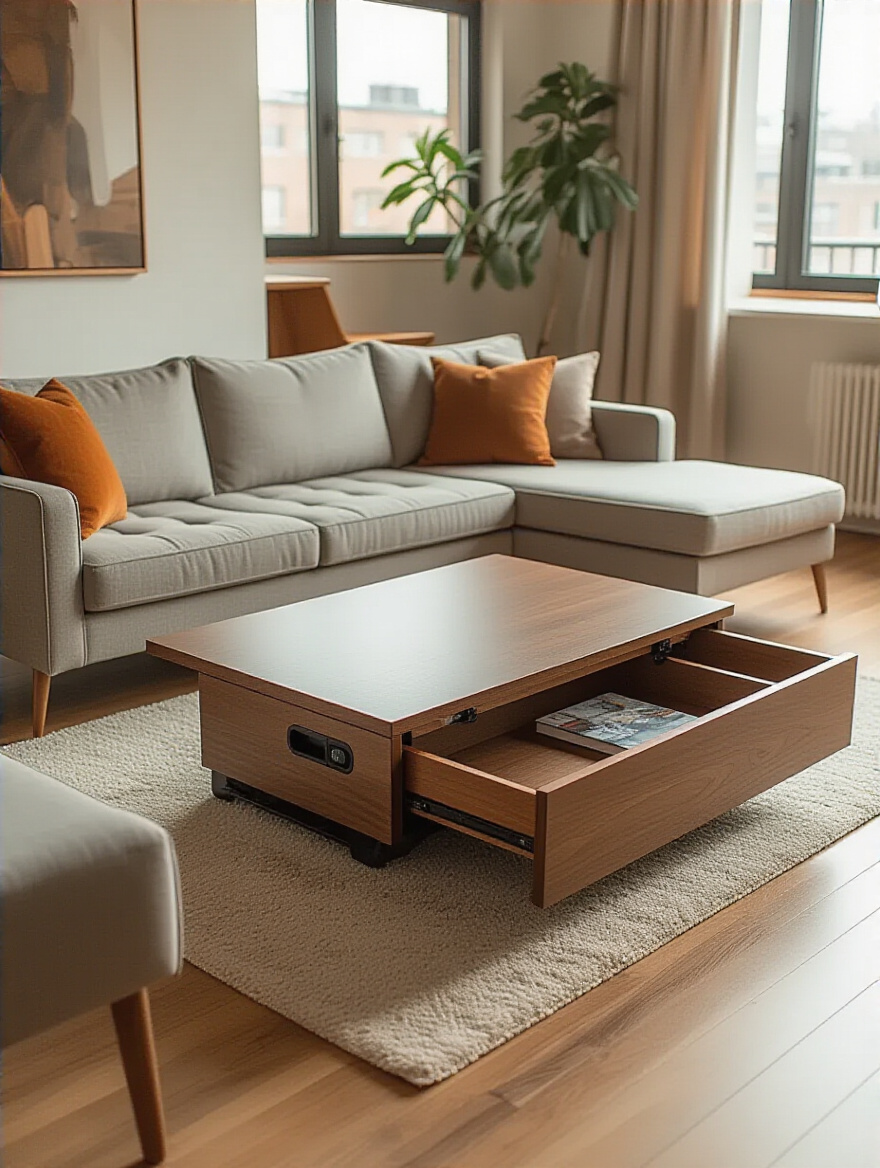
Look for furniture that has a “second major.” Think nesting tables that can be pulled out for guests and tucked away when you’re alone, a sleeper sofa that turns your living room into a guest room, or a console table that can also serve as a slim bar or media stand. The BS to avoid here is cheaply made convertible furniture with clunky mechanisms. Invest in quality pieces that transform smoothly; otherwise, you’ll never actually use their secondary function. I always tell clients that great multifunctional furniture doesn’t just save space; it expands the possibilities of how you can live in that space.
When every piece serves multiple needs, you can own less stuff while getting more function, which is the key to an uncluttered and highly efficient home.
7. Ground Your Space with an Area Rug That Defines Boundaries and Adds Warmth
A living room without an area rug often feels like a collection of random items floating in space. A rug is the anchor. It pulls all the individual pieces of your seating area together into a single, cohesive unit. It’s like drawing a circle around your friends at a party—suddenly, you have a defined conversation group. It also adds a critical layer of texture and warmth, which is essential for making an apartment feel like a home.
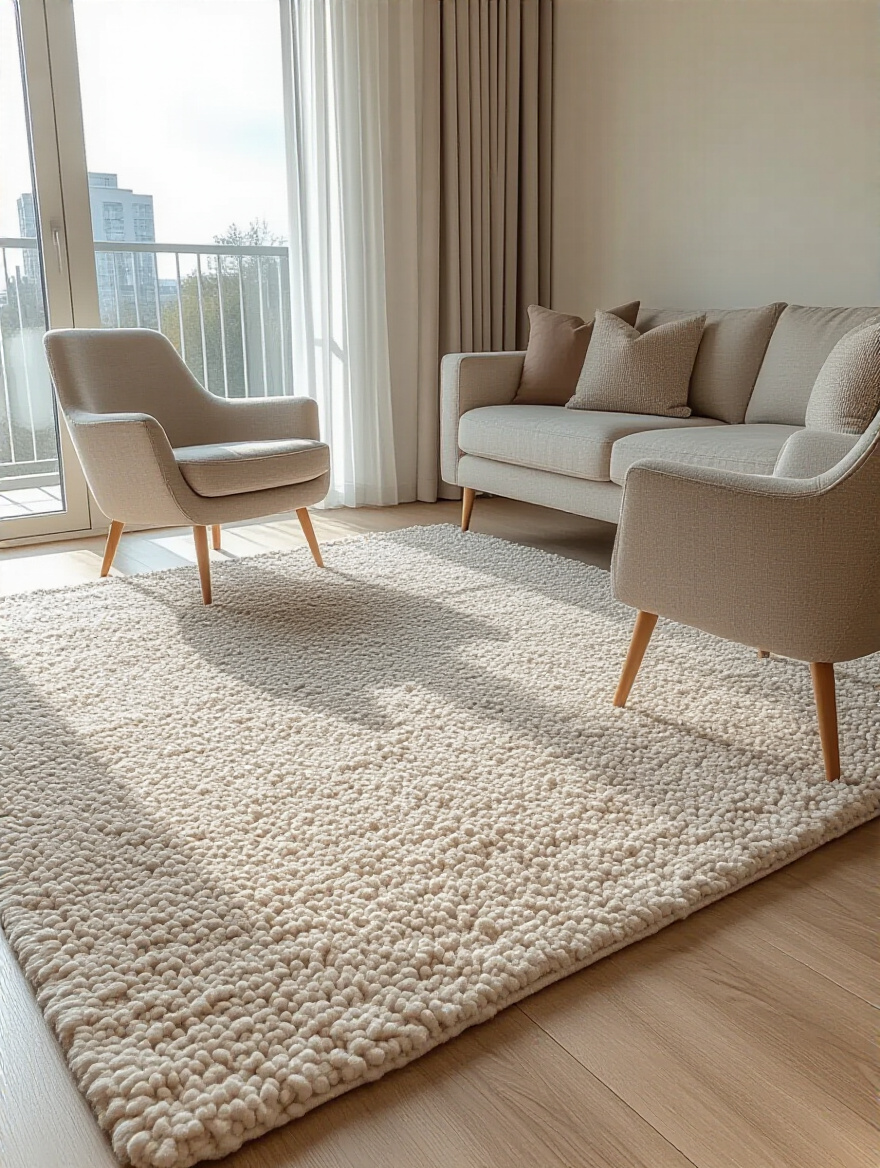
The biggest mistake people make is buying a rug that’s too small. A tiny “postage stamp” rug will only make your room look smaller and more disjointed. The golden rule is that at least the front legs of your sofa and any armchairs should be sitting comfortably on the rug. This visually connects everything. I had a client who was convinced her living room was too small for an 8×10 rug. We laid one down, and the room instantly felt bigger because the rug created one large, unified zone instead of several small, floating pieces of furniture.
The right rug defines your main living zone, adds critical comfort and sound absorption, and makes the entire space feel more intentional and complete.
8. Arrange Seating to Encourage Comfort and Facilitate Easy Conversation
Remember the “furniture against the walls” problem? Let’s fix it. The purpose of a living room is to live in it, which usually involves interacting with other humans. You can’t have a good conversation if you have to shout across a vast, empty expanse. Your seating arrangement should feel intimate and inviting, making conversation easy and natural.
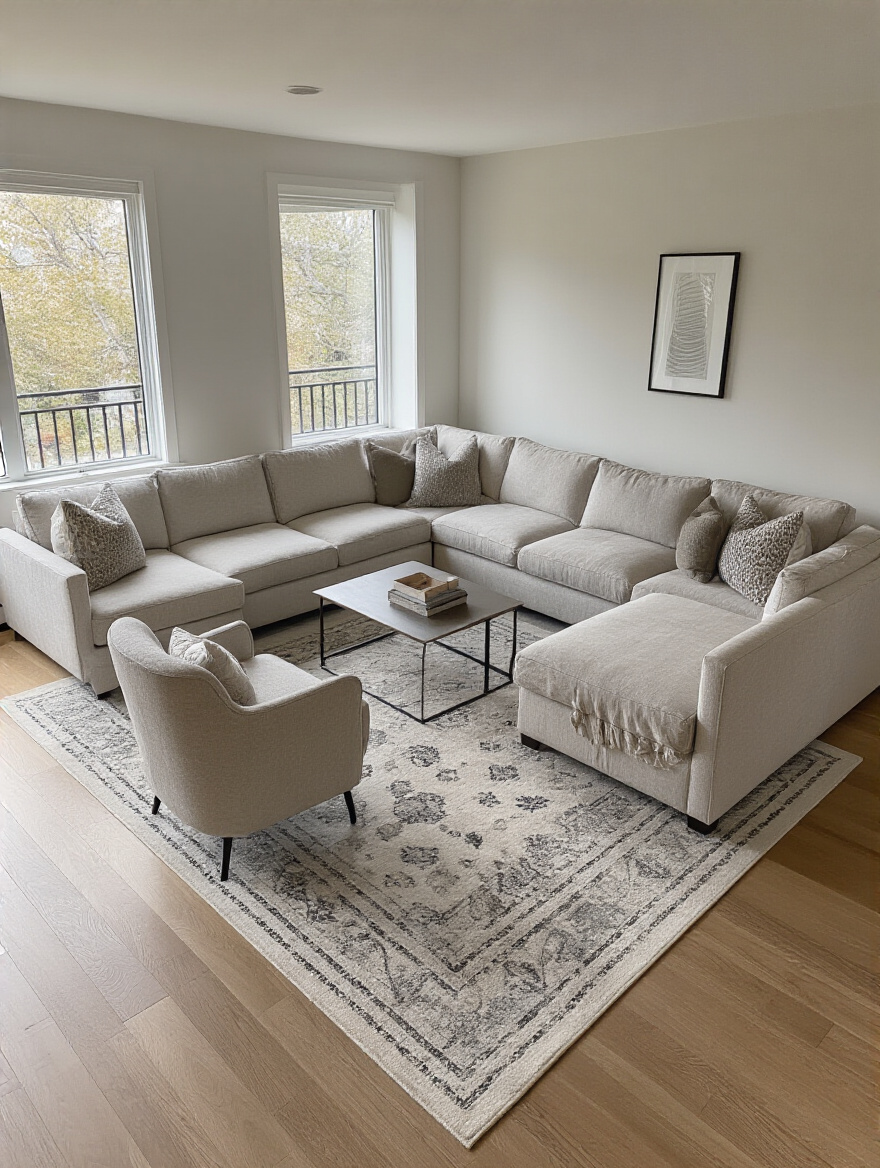
Pull your furniture away from the walls and arrange it to create a conversational grouping. Sofas and chairs should face each other, not just all bow down to the TV. A good rule of thumb is to keep seating pieces within about 8 feet of each other—close enough to talk without raising your voice, but far enough for personal space. Use your area rug as a guide; your seating should be clustered on and around it. This creates a cozy, defined zone that feels instantly welcoming.
This one change—pulling furniture away from the walls and toward each other—is the fastest way to make your living room feel more sophisticated and functional.
9. Integrate Smart Vertical Storage Solutions to Conquer Clutter Effectively
When you can’t build out, you have to build up. Vertical space is the most underutilized real estate in any apartment. By using tall, slender bookcases, floating shelves, and wall-mounted cabinets, you draw the eye upward, creating an illusion of height while freeing up precious floor space. This is how you conquer clutter for good.
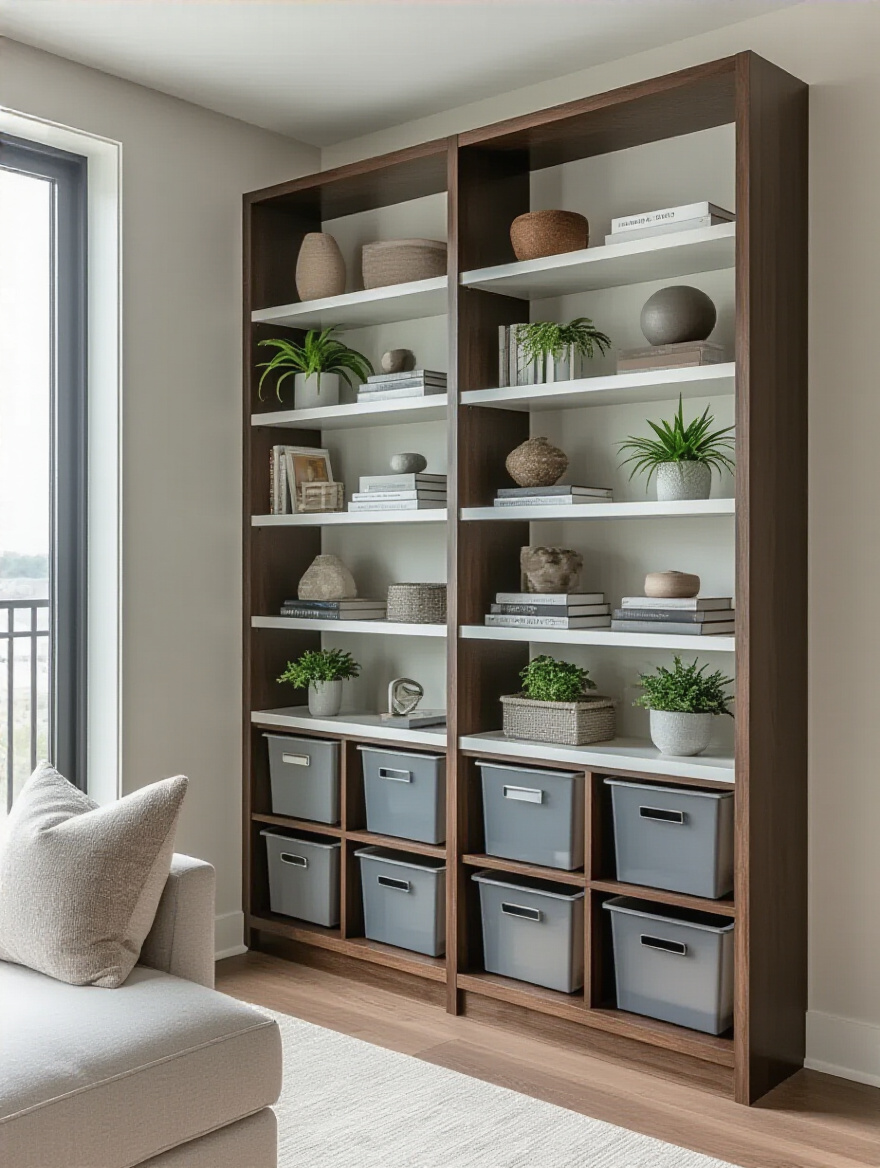
Forget clunky, deep bookcases. Look for slim, floor-to-ceiling units that offer maximum storage on a minimal footprint. Floating shelves are perfect for displaying decor without the visual weight of a piece of furniture. A great trick is to install shelves just above a doorway or run a long picture ledge along an entire wall. It adds architectural interest and gives you a home for books, plants, and photos without taking up a single square inch of your floor.
My mantra for every client is: “Get it off the floor.” The more floor you can see, the larger and more open your space will feel.
I helped a couple in a tiny studio reclaim their living space by installing a wall-mounted media unit with integrated shelving that went almost to the ceiling. It housed their TV, books, and media, eliminating three separate pieces of furniture and making the room feel twice as big overnight.
Furnishing Essentials: Core Layout & Key Pieces (Part 2)
With the main furniture laid out, it’s time for the strategic players—the pieces that don’t just furnish but actively manipulate the space to your advantage. These are the secret weapons that add personality, light, and a sense of expansiveness.
10. Place Mirrors Artfully to Amplify Light and Create a Sense of Spaciousness
A large mirror is the oldest trick in the small-space design book for a reason: it works. A mirror is basically a fake window. It bounces light around the room, making it feel brighter and more open, and it creates an illusion of depth that can make a wall seem to disappear. But placement is everything.
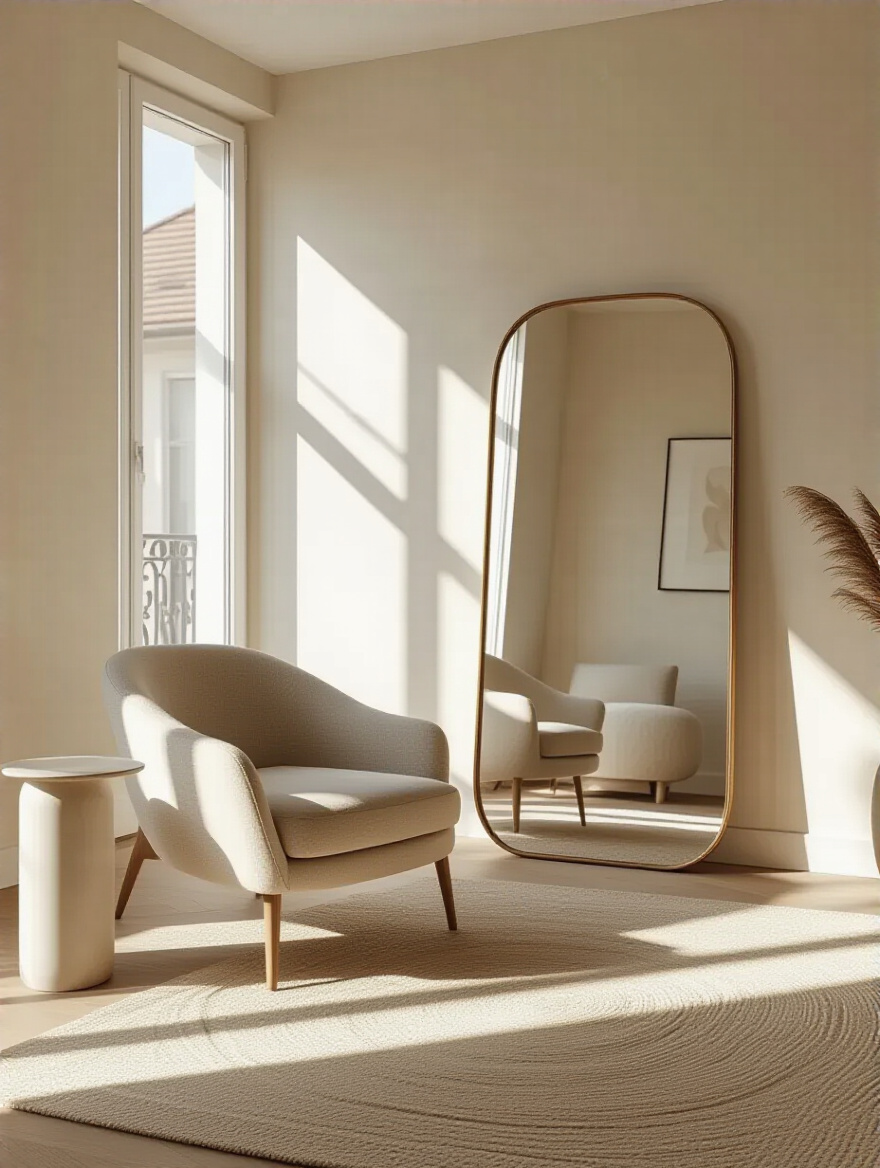
The biggest mistake is hanging a mirror where it reflects something boring or cluttered, like a blank wall or a messy hallway. The best place for a mirror is opposite a window to capture and double the natural light. You can also place it to reflect a beautiful piece of art or a striking light fixture, essentially getting two for the price of one. A tall, full-length mirror leaned against a wall is a fantastic, renter-friendly option that adds a casual, sophisticated vibe and dramatically expands the sense of space.
Think of a mirror not as decoration, but as a functional tool for light and space manipulation, and you’ll unlock its full potential.
11. Curate Meaningful Artwork and Wall Decor to Inject Personal Character
Blank walls are a wasted opportunity. Your walls are the perfect place to tell your story and inject your personality into your home without taking up any floor space. Meaningful artwork transforms a generic rental into a place that is undeniably yours. This isn’t about buying expensive art; it’s about curating a collection of things that you love.
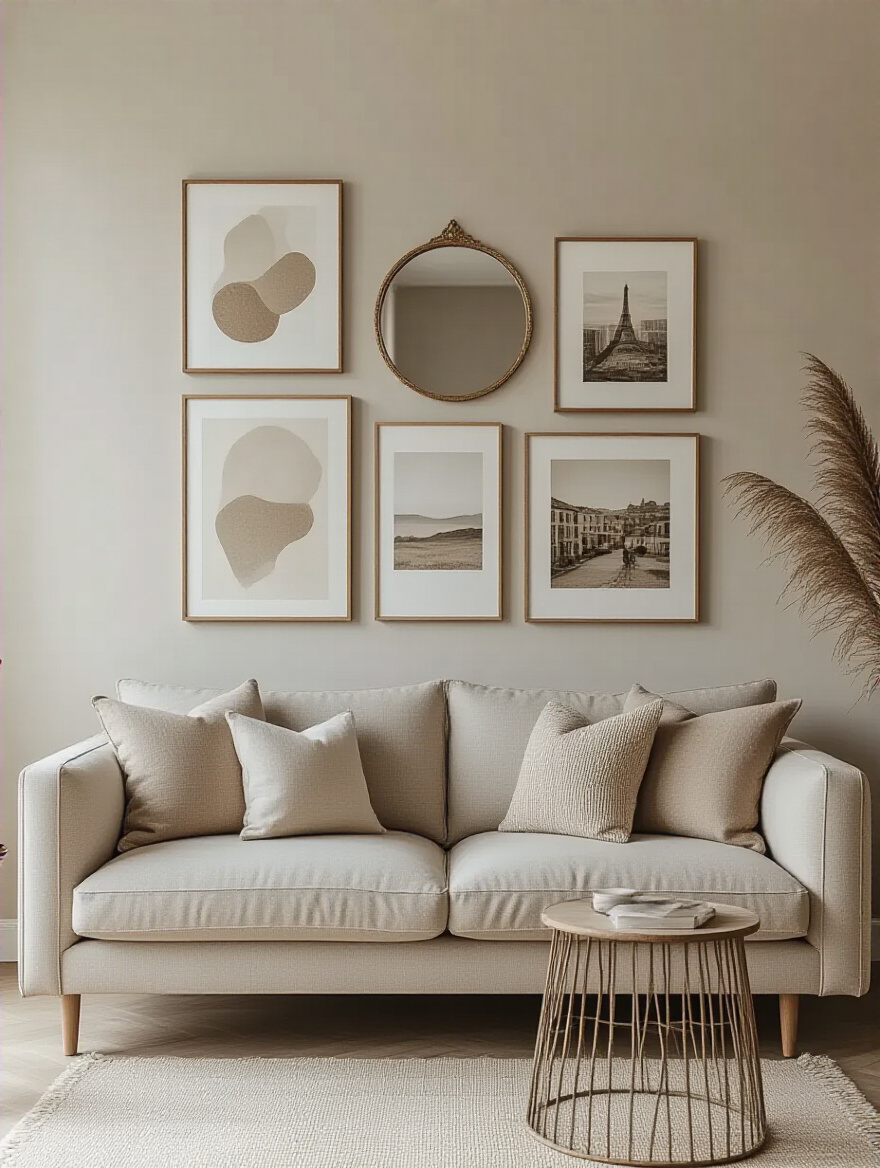
Whether it’s a gallery wall of family photos, a large abstract canvas that provides a pop of color, or framed prints from a favorite artist on Etsy, your wall decor should reflect your passions and history. A pro tip for gallery walls is to lay all your frames out on the floor first and play with the arrangement until you get it right. Then, trace each frame onto paper, tape the paper cutouts to the wall to perfect the layout, and then nail right through the paper. It saves you from a dozen misplaced nail holes.
Well-chosen art is the soul of a room. It gives the eye a place to land and makes the space feel layered, personal, and complete.
12. Layer Ambient, Task, and Accent Lighting to Craft Desired Moods
We touched on this before, but it’s so important it deserves its own spot. Layering your light sources is the key to creating a dynamic, versatile room. A single overhead light creates a flat, one-dimensional space. Combining different types of lighting allows you to change the entire mood of the room with the flip of a few switches.
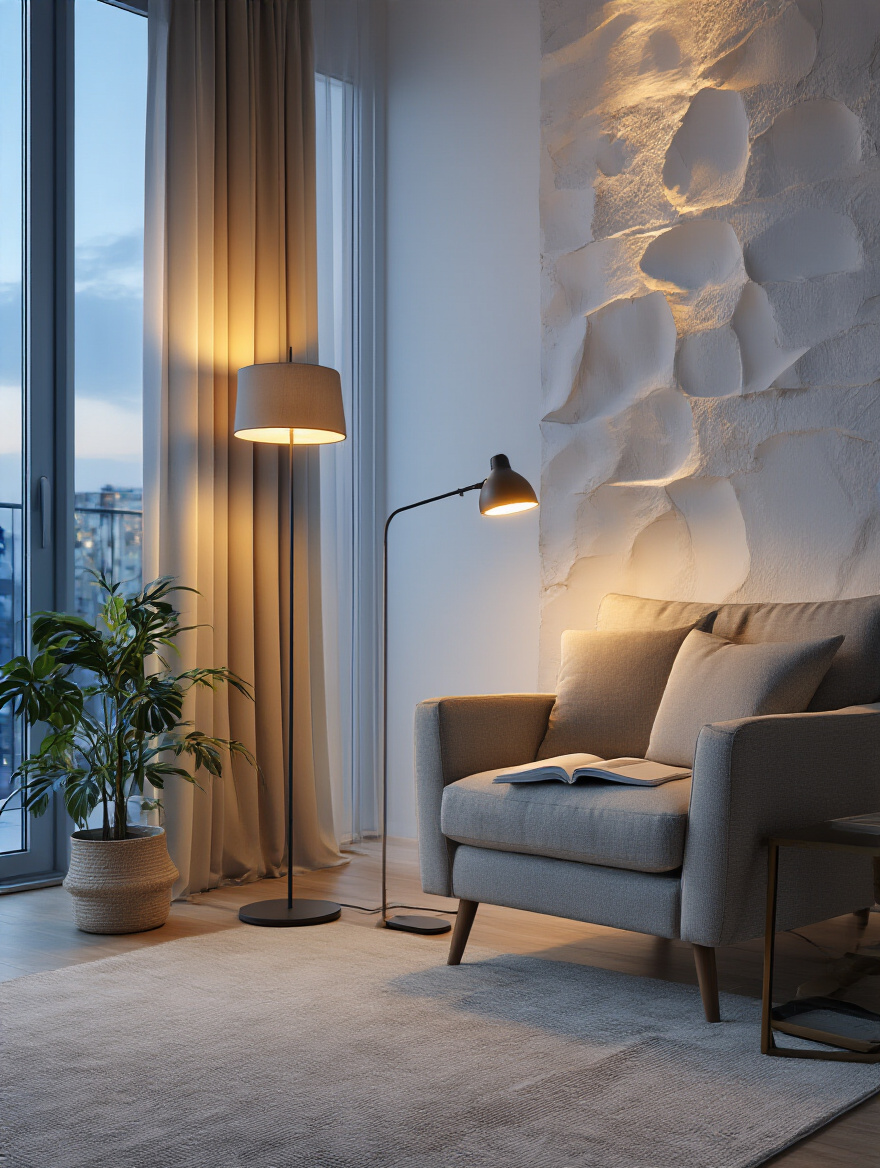
Here’s a practical setup for an apartment living room: install a dimmer on your main overhead light for ambient control. Add a stylish floor or table lamp next to your sofa for task lighting for reading. Then, place a small, inexpensive uplight behind a large plant or a bookcase to create a soft, accent glow. Using smart bulbs is a game-changer here, as you can control the brightness and even the color temperature of each light from your phone, crafting the perfect vibe for any occasion.
This systematic approach to lighting is what separates an amateur room from a professionally designed one. It adds depth, warmth, and incredible functionality.
Styling & Sensory Enhancement: Adding Depth & Detail (Part 1)
With the bones of the room in place, it’s time for the finishing touches. This is where you add the layers that make a space feel rich, inviting, and truly comfortable. It’s all about engaging the senses.
13. Introduce Diverse Textures with Throw Pillows and Blankets for Inviting Warmth
A room with only smooth, flat surfaces can feel cold and sterile. Texture is what makes a space feel cozy and inviting. The easiest and most affordable way to do this is with textiles like throw pillows and blankets. They’re the sweaters and scarves of your living room, adding instant warmth and personality.
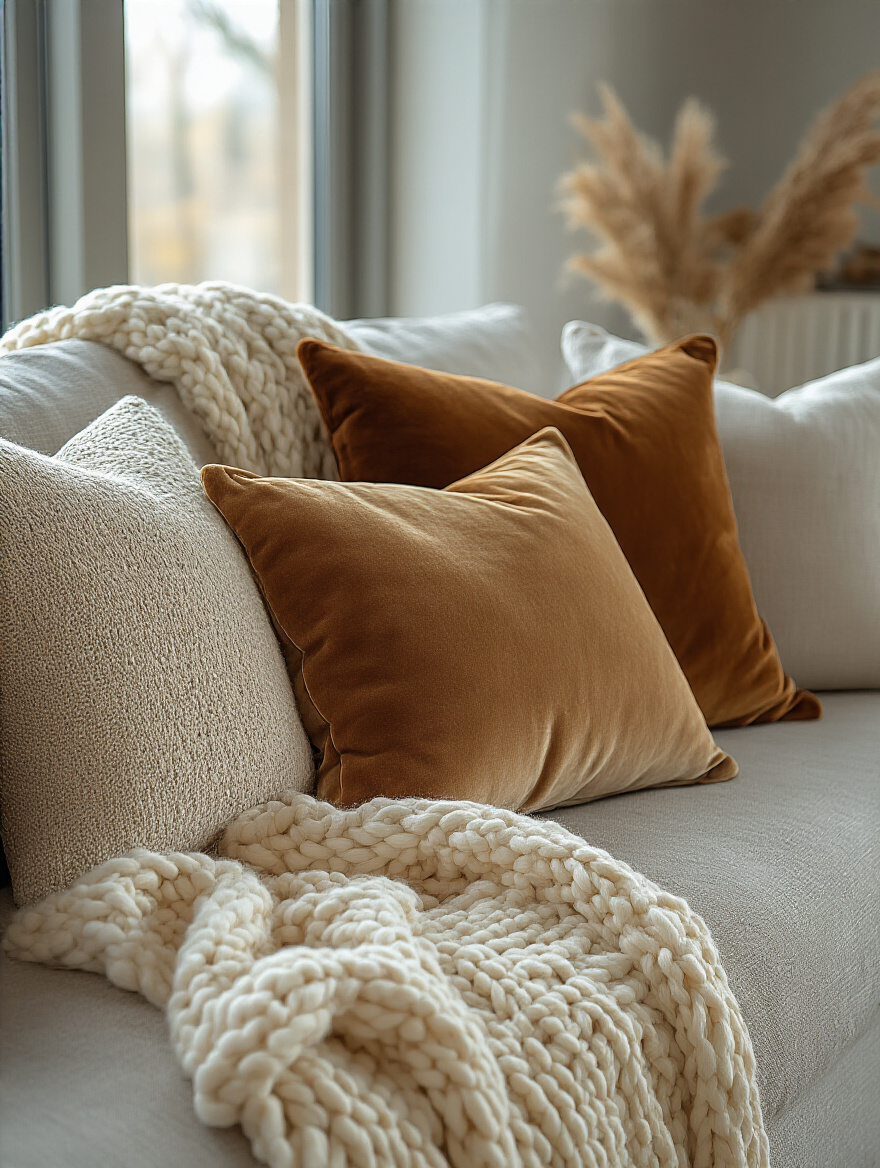
Don’t just buy a matching set of pillows. Mix it up! Combine different materials—velvet, linen, chunky knit, faux fur, woven cotton—to create a rich, tactile experience. Vary the sizes and shapes of your pillows, too. A mix of squares, lumbars, and even a round one feels much more curated and less “straight out of the bag.” A chunky knit blanket draped over the arm of the sofa doesn’t just add warmth; it adds a layer of visual interest that breaks up the large, solid block of the sofa.
This is a low-commitment way to experiment with color and pattern, and it’s the secret to achieving that effortlessly cozy, “lived-in” look.
14. Style Open Shelves and Tabletops with Curated Vignettes Reflecting Personality
Open shelves and coffee tables can quickly become magnets for clutter. The key is to style them intentionally with “vignettes”—small, curated groupings of objects that tell a story. This isn’t about just placing things; it’s about arranging them with purpose.
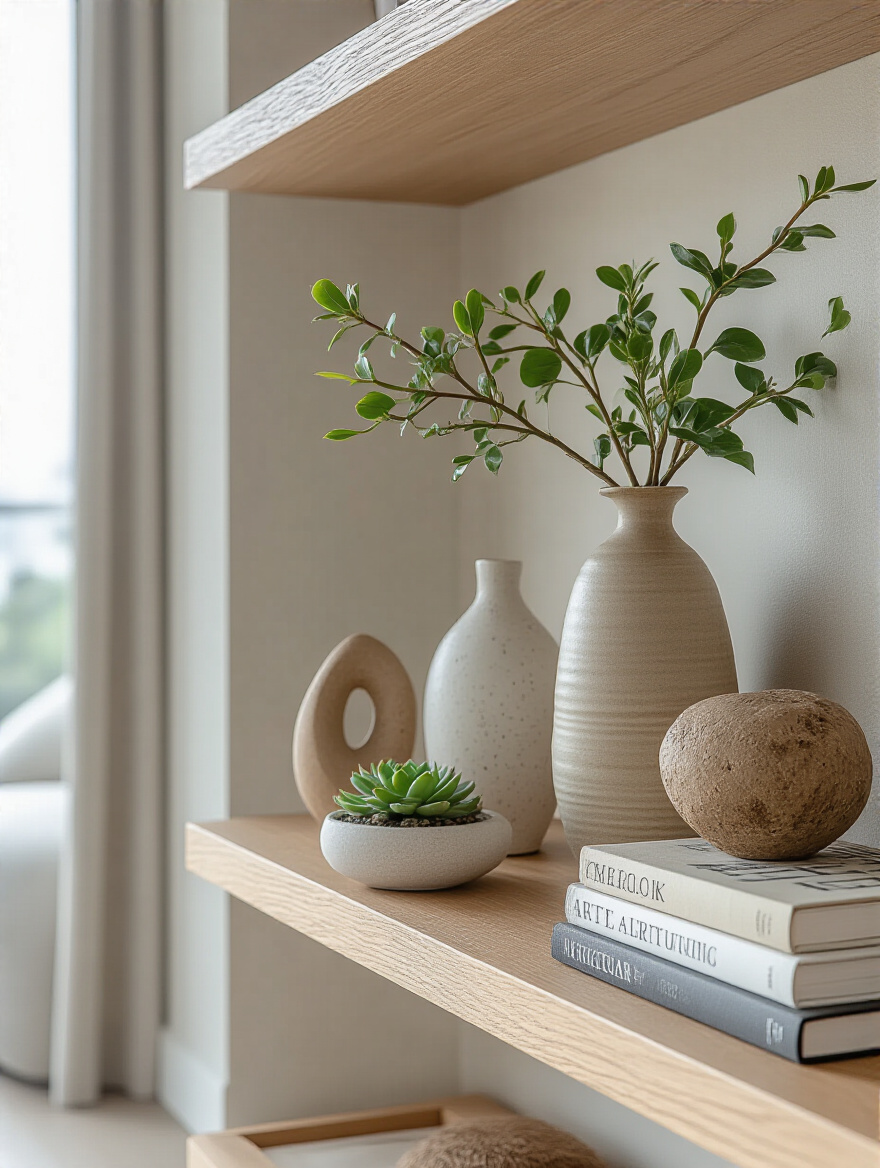
A great formula for a vignette is to use the “Rule of Three”: group items in odd numbers. Combine objects of varying heights—something tall (like a vase with branches), something medium (like a stack of books), and something low (like a small decorative bowl). Mix textures and materials. Most importantly, leave some empty space—what designers call “negative space.” It allows each object to breathe and prevents the surface from looking cluttered. Use a tray to corral smaller items on a coffee table; it instantly makes a collection of items look like one cohesive unit.
These small, intentional moments are what elevate a room from simply furnished to thoughtfully styled.
15. Incorporate Live Plants and Greenery to Bring Life and Freshness Indoors
Every single room, without exception, looks better with a plant in it. Plants add life, color, and a natural, sculptural element that you just can’t get from anything else. They also purify the air and have been proven to boost your mood. In an urban apartment, they provide a vital connection to nature.
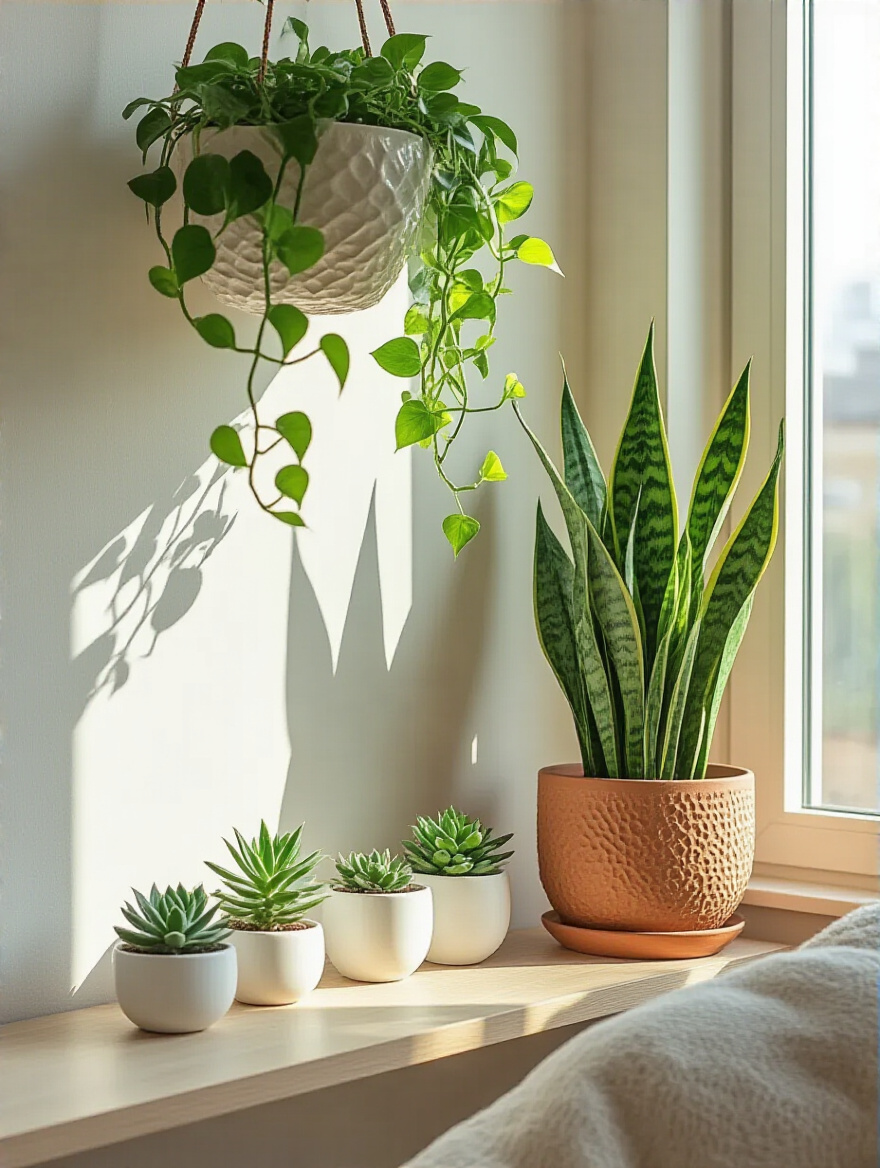
You don’t need a green thumb. There are plenty of beautiful, nearly indestructible plants perfect for apartment living. Snake plants and ZZ plants tolerate low light and infrequent watering. Pothos plants are beautiful trailers that are ridiculously easy to care for. Use plants to fill awkward empty corners with a tall floor plant like a Fiddle Leaf Fig, or use hanging planters to add greenery without taking up any surface space.
Plants make a space feel alive and cared for, adding a layer of freshness that no amount of decor can replicate.
16. Optimize Window Treatments for Desired Light Control and Privacy Levels
Bare windows can make a room feel unfinished and exposed. The right window treatments offer a triple threat of benefits: they control light, provide privacy, and add a crucial soft, textural element to the room. Ditching the standard-issue plastic blinds is one of the biggest upgrades you can make.
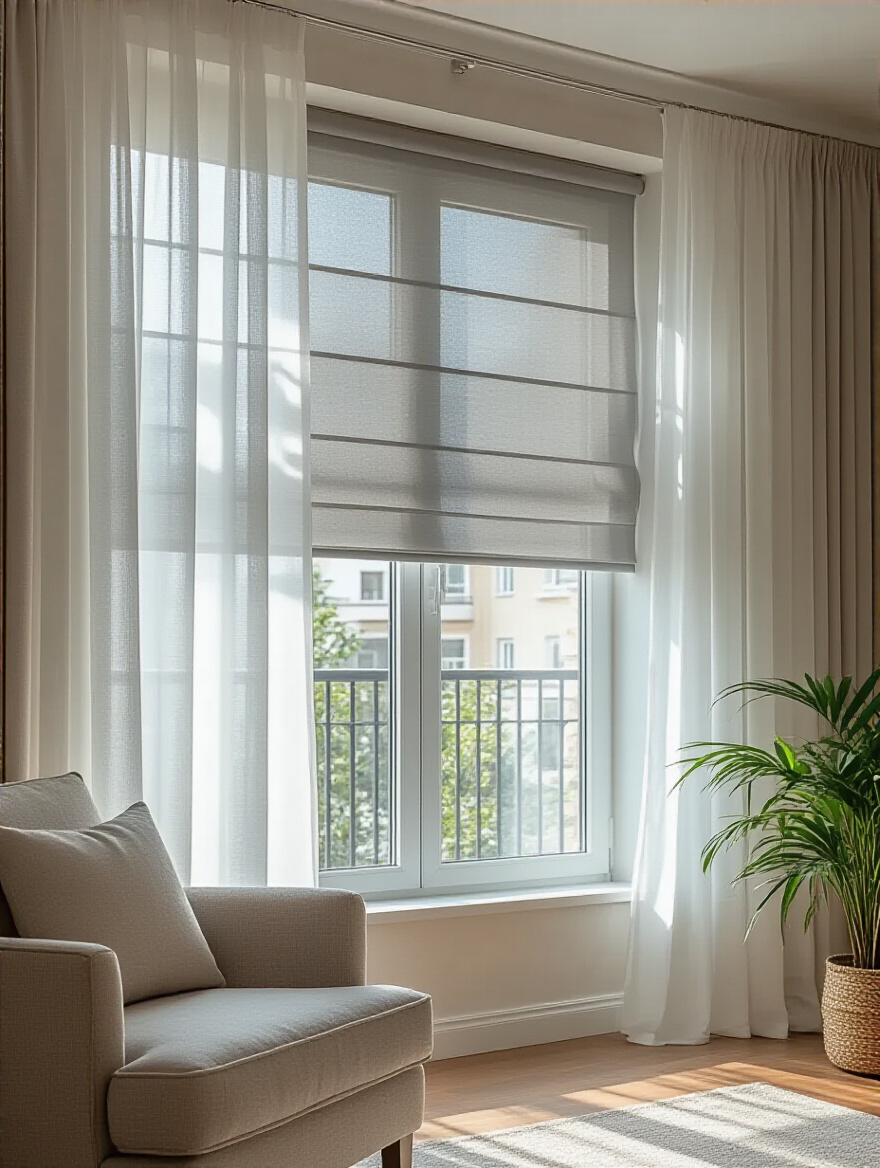
The trick professional designers use is to hang the curtain rod high and wide. Mount the rod 4-6 inches above the window frame and extend it 6-12 inches on either side. This makes your window appear much larger and allows you to pull the curtains completely clear of the glass when they’re open, maximizing natural light. For ultimate flexibility, layer a sheer curtain (for soft, filtered light and daytime privacy) with an opaque drape (for blocking light and ensuring nighttime privacy).
This simple framing technique adds a sense of height and elegance to the room while giving you complete control over your environment.
Styling & Sensory Enhancement: Adding Depth & Detail (Part 2)
Let’s push the functionality even further. A truly great small living room isn’t just styled; it’s engineered for flexibility, ready to adapt to whatever your life throws at it.
17. Add Accent Furniture and Ottomans for Flexible Seating and Surface Space
Your primary seating is set, but what happens when you have more than two friends over? This is where small, mobile accent pieces become your best friends. Lightweight armless chairs, garden stools, or sturdy poufs can be tucked into corners or under a console table and then pulled out whenever you need extra seating.
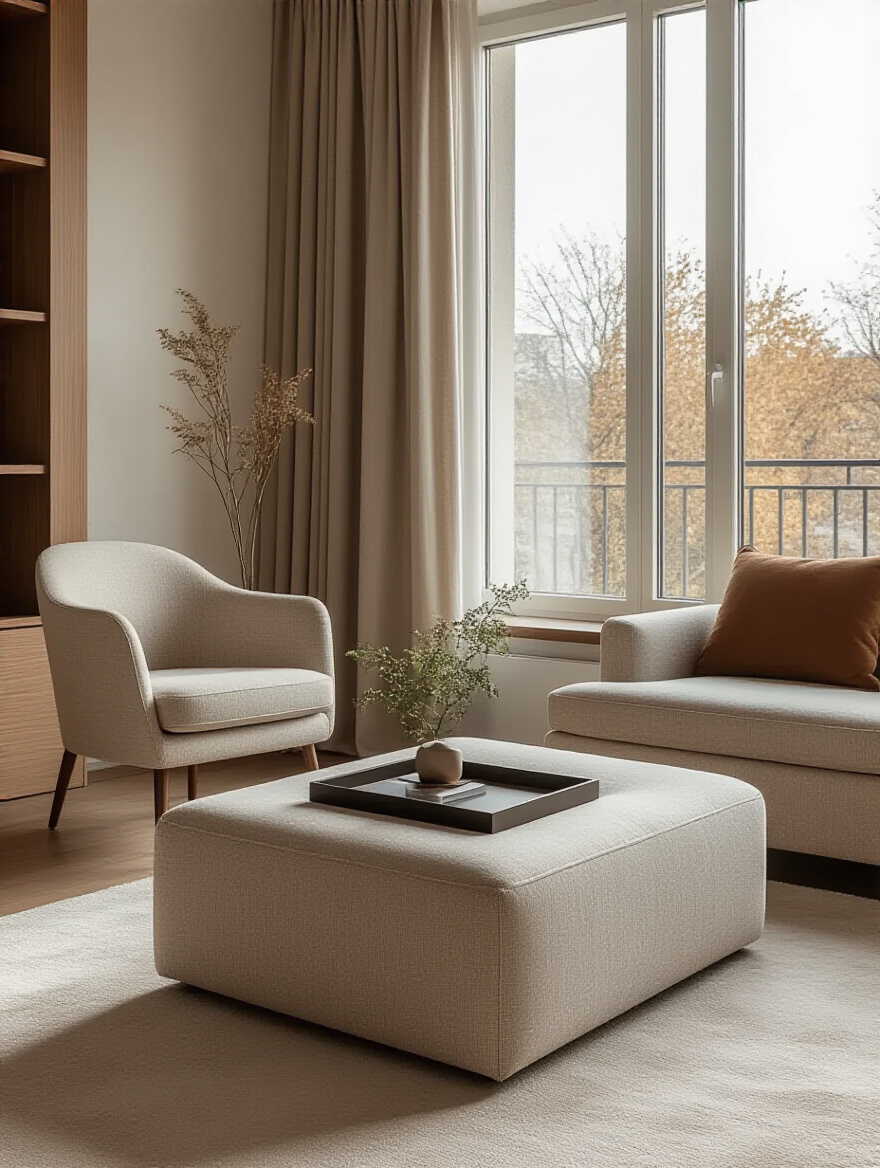
A firm, upholstered ottoman is one of the most versatile pieces you can own. It can be a footrest, extra seating, or—with a tray on top—an instant coffee table. I once had a client with a tiny living room who used two small cube ottomans as their “coffee table.” When guests came over, the cubes split apart to become seats, completely opening up the floor space for mingling.
These flexible pieces allow your room to expand and contract its function on demand, ensuring you’re always ready for a quiet night in or a last-minute get-together.
Personalization & Enduring Appeal: Refinement & Care
Finally, a well-designed room isn’t a finished project; it’s a living thing. The final touches are about making it deeply personal and ensuring it stays a serene, beautiful space for years to come.
18. Display Personal Mementos and Collectibles to Tell Your Unique Story
This goes beyond just hanging art. This is about weaving your personal history into the fabric of the room. That collection of seashells from a memorable vacation, your grandmother’s antique camera, a row of books that changed your life—these are the things that make your home uniquely yours.
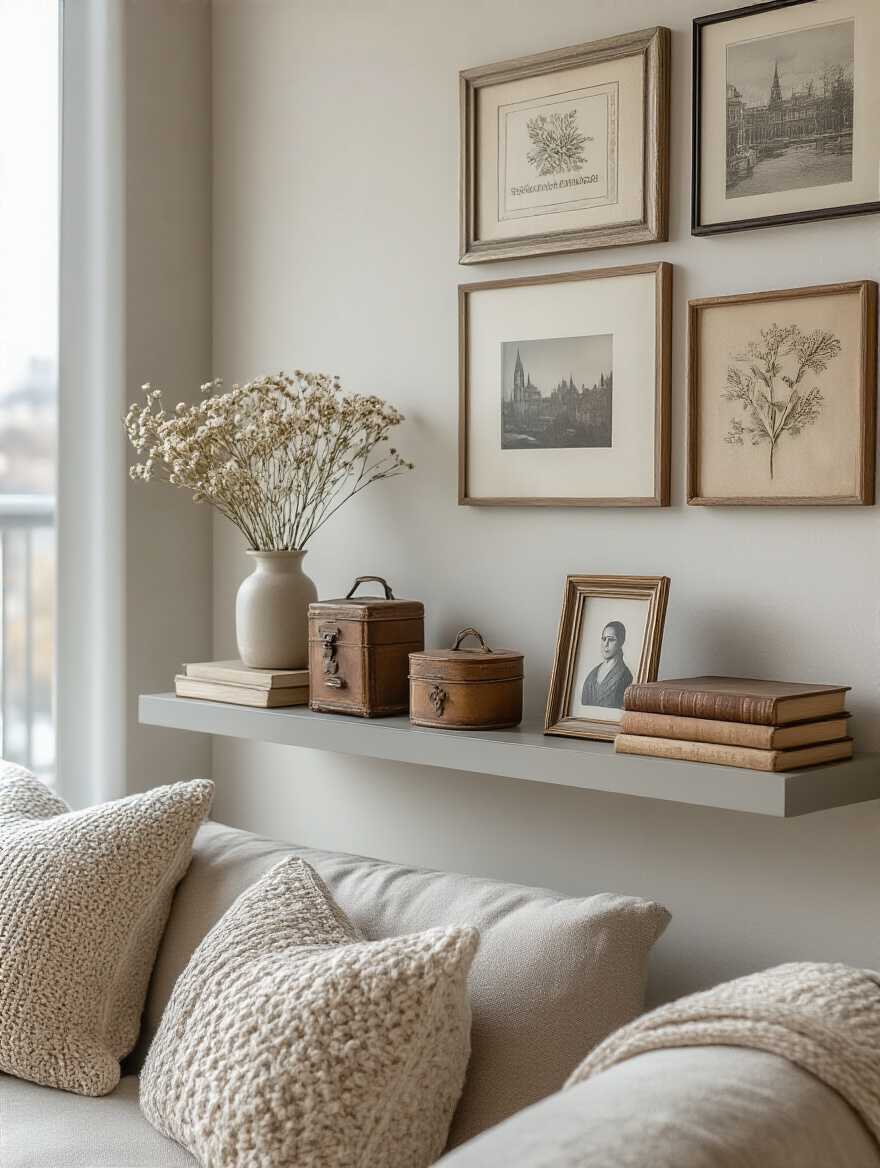
Instead of scattering them around, group them to give them more impact. A shadow box is perfect for small, delicate items. A “picture ledge” is a shallow shelf that’s brilliant for displaying framed photos, small sculptures, and souvenirs because you can easily rearrange them without putting more holes in the wall. The key is curation. Not everything you own needs to be on display at once. Rotate items to keep the display feeling fresh and meaningful.
These personal layers are what turn a house into a home. They’re conversation starters and daily reminders of the life you’ve lived.
19. Refresh Decor Seasonally to Keep Your Living Space Vibrant and Current
Your living room doesn’t have to be static. A simple seasonal refresh is an easy and affordable way to keep the space from feeling stale. This doesn’t mean a complete overhaul. It’s about swapping out a few key, low-cost items.
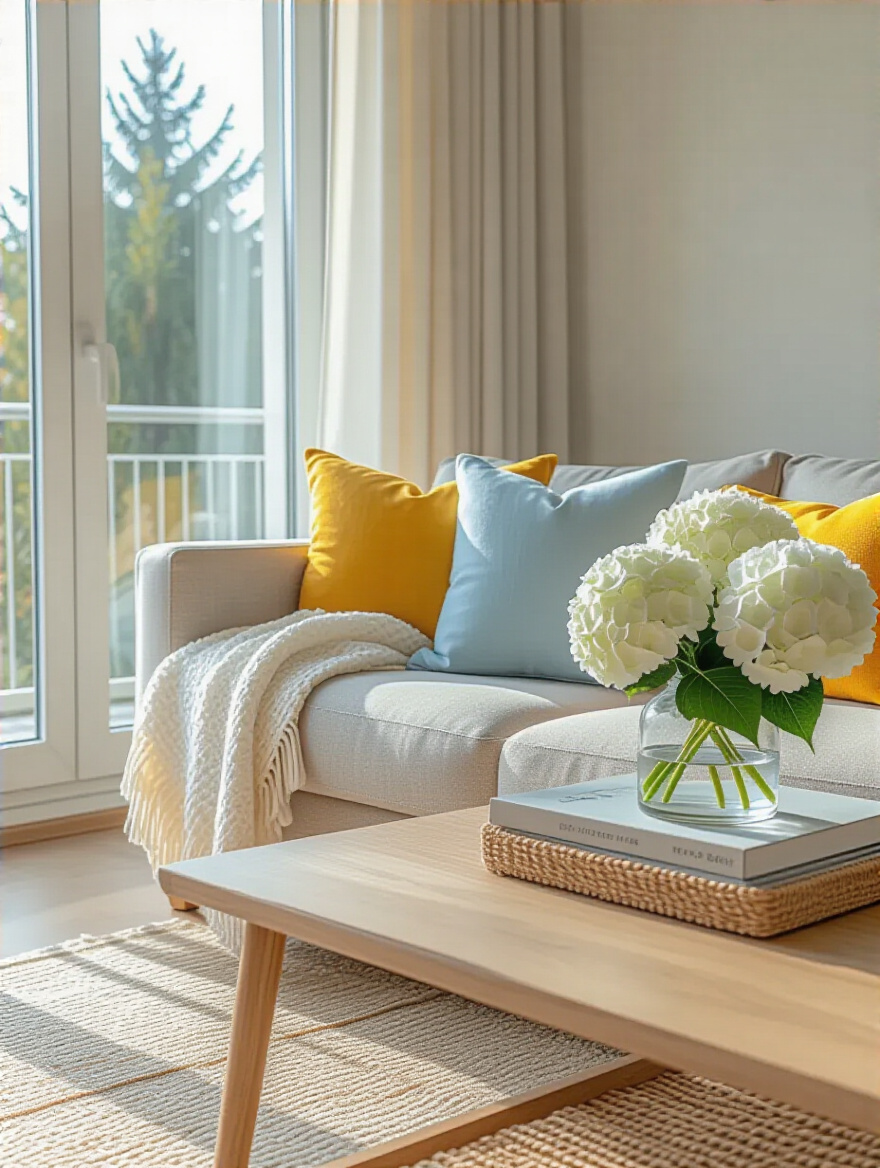
In the fall and winter, bring in heavier textures like wool or velvet pillows in warmer, deeper colors and a cozy throw blanket. In the spring and summer, switch to lightweight linen or cotton textiles in brighter colors, and swap out a dark art print for something lighter. Even just changing the scent of a candle or putting fresh seasonal branches in a vase can completely shift the mood of the room. Having a designated bin for your “off-season” decor makes this swap-out a quick, 20-minute task.
This simple routine ensures your home feels in sync with the world outside and gives you that “new room” feeling four times a year.
20. Implement a Consistent Decluttering Strategy for a Serene, Lasting Appeal
This is the least sexy tip, and it is by far the most important. All the brilliant design in the world will be buried under a pile of mail, random magazines, and accumulated stuff. The only way to maintain a beautiful, functional space is with a relentless commitment to decluttering.
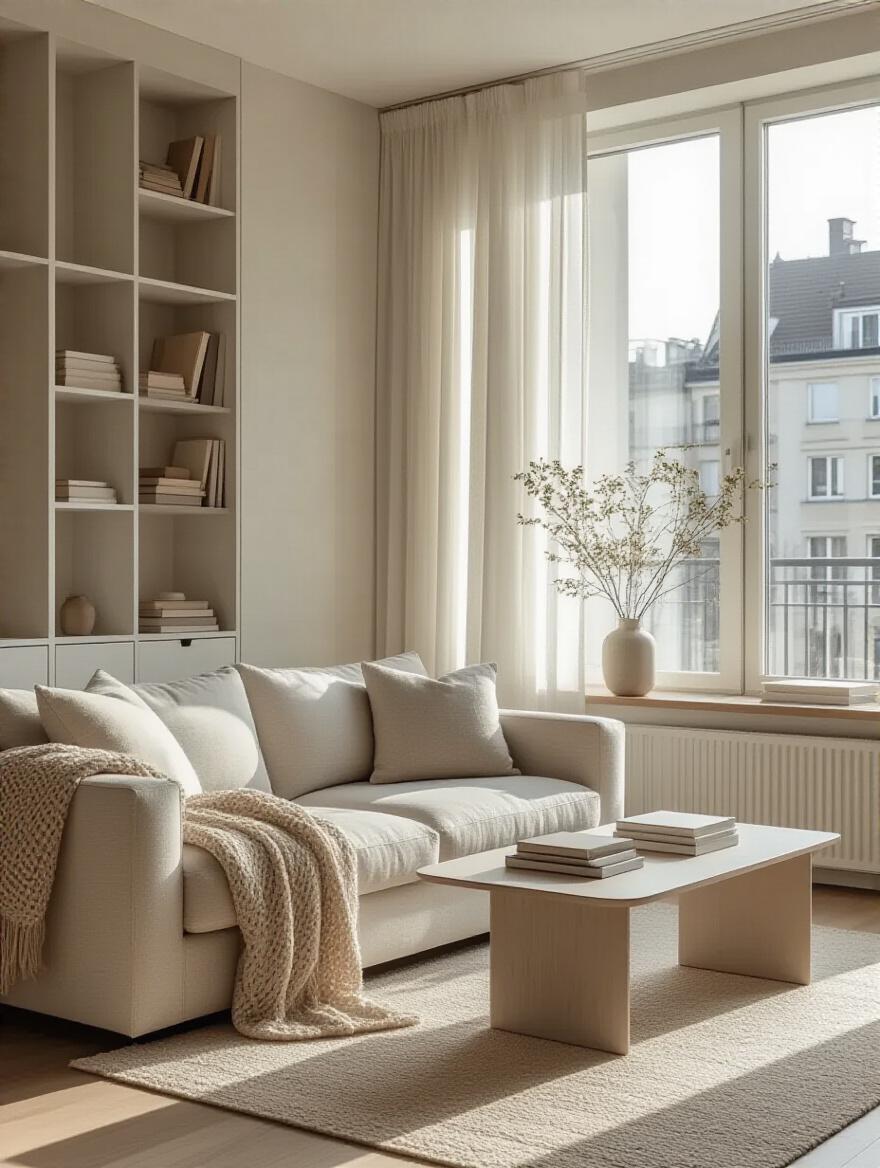
The most effective strategy is to build small habits. Implement the “one-in, one-out” rule: when you buy a new book, one has to go. Do a 10-minute “room reset” every night before bed where you put everything back in its designated home. Keep a basket near the door for donations, and toss things in it the moment you decide you no longer need them. Clutter is just a series of postponed decisions. By making those decisions quickly and consistently, you prevent chaos from ever taking hold.
An organized space is not about perfection; it’s about creating systems that make it easier to live the way you want to live.
A decluttered room is a serene room. It’s the foundation upon which all good design is built, ensuring your beautiful apartment stays that way for the long haul.
Conclusion
So there you have it—the complete system for turning a cramped apartment living room into a space that is stylish, incredibly functional, and a true reflection of you. It’s not about magic or having a huge budget. It’s about being intentional. It starts with a solid plan, layering in smart, hard-working furniture, and finishing with personal details that make it feel like home.
Don’t get overwhelmed and try to do all 20 things at once. Pick one. Start with a floor plan, or simply commit to finding a proper home for everything on your coffee table tonight. Each small, strategic choice builds on the last, creating a space that not only looks beautiful but makes your daily life easier and more enjoyable. Your organized, space-maximized sanctuary is waiting.


